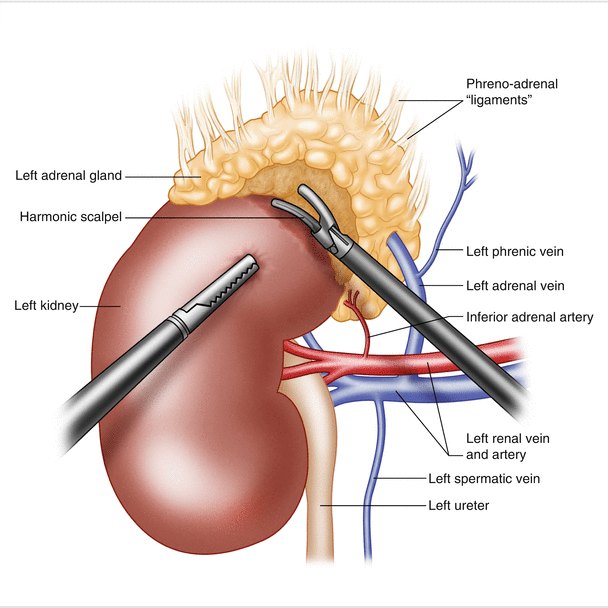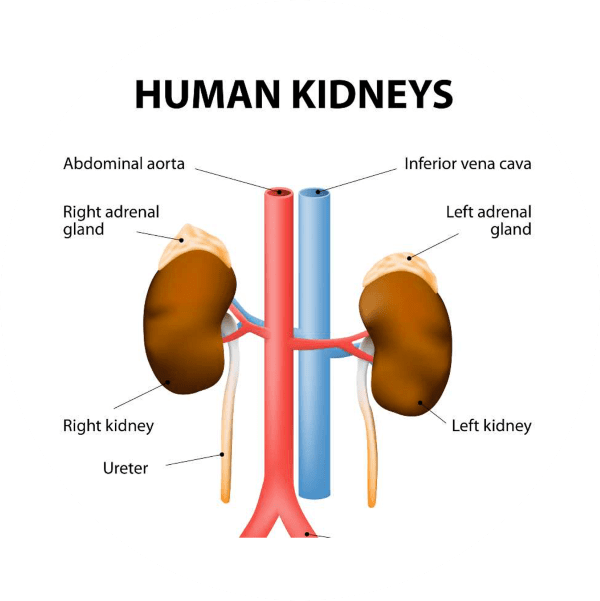Adrenal Gland Surgery Adelaide
Dr Samuel Rice – MBBS, FRACS
Specialist Surgeon
Learn more about the adrenal glands and adrenal gland removal surgery.
What happens when the adrenal glands do not function properly
The two common ways in which adrenal glands cause health issues are by producing too little or too much of certain hormones, which leads to hormonal imbalances.
These abnormalities of the adrenal function can be caused by various diseases of the adrenal glands or the pituitary gland.
1. Adrenal insufficiency – Adrenal insufficiency is rare. It may be caused by disease of the adrenal glands or by diseases in the hypothalamus or the pituitary gland. The symptoms include but are not limited to weight loss, poor appetite, nausea, vomiting, fatigue and abdominal pain.
The causes may include autoimmune disorders, genetic disorders, fungal and other infections, cancer (rarely) and genetic factors.
2. Overactive Adrenal Glands – Sometimes, adrenal glands may develop nodules that produce too much of certain hormones and may cause:
- Cushing syndrome – This results from excessive production of cortisol from the adrenal glands. The symptoms may include weight gain and fatty deposits in certain areas of the body, thinning arms and legs, purple stretch marks on the abdomen, facial hair, fatigue, muscle weakness, easily bruised skin, high blood pressure, diabetes, and other health issues.
- Hyperaldosteronism – This results from overproduction of aldosterone from one or both adrenal glands. This is characterised by increase in blood pressure, low potassium levels, muscle aches, weakness and spasms.
- Pheochromocytoma – This is a tumor that results in excess production of adrenaline or noradrenaline and may cause high blood pressure. Other symptoms include headaches, sweating, tremors, anxiety and rapid heartbeat. Some people are genetically predisposed to developing this type of tumor.
Adrenal Cancer – Malignant or cancerous adrenal tumors can release excess of one or more hormones accompanied by abdominal pain, flank pain or a feeling of abdominal fullness.
Treatments for Adrenal Gland Disorders
Dr Rice may recommend a non-surgical or surgical approach for adrenal gland disorders dependant on your specific situation.
The approaches may include:
Dr Rice may recommend additional tests to confirm your diagnosis and ensure you understand the treatment options available in relation to your diagnosis and specific situation.
Adrenal Gland Surgery
Dr Rice may perform an adrenalectomy (adrenal gland removal surgery) via minimally invasive or traditional open surgery. The procedure used by Dr Rice will depend on your unique medical circumstances.
Minimally invasive surgery – Minimally invasive (laparoscopic) surgery to remove the adrenal gland is performed through several small incisions made through the patients back and side. The patient is asleep under general anaesthetic on their stomach. This type of surgery uses a tiny camera and surgical instruments that allows Dr Rice a 3D view of the surgical site. The benefits of minimally invasive surgery may include smaller scars, less pain and a shorter recovery period than traditional open surgery.
Open surgery – Depending on your specific situation Dr Rice may recommend open surgery. Open surgery is performed using traditional instruments and a larger incision to access the abdominal cavity to remove the adrenal gland or glands.
Dr Rice will explain your treatment options and discuss whether an adrenalectomy is the most appropriate treatment for your situation.

What happens during Adrenal Surgery
Adrenal surgery is performed whilst you are under a general anaesthetic. This means you are asleep during surgery. Your anesthesiologist will put you sleep before the operation and a breathing tube will then be placed in your trachea to assist breathing throughout the surgery.
The surgical team will places several monitors on your body to help make sure that your heart rate, blood pressure and blood oxygen remain at safe levels throughout the operation.
During the procedure – Once you’re unconscious, Dr Rice will make the necessary incision/s. All or part of the adrenal glands is removed, depending on the reason for the surgery. Dr Rice will delicately separate the adrenal gland from its attachments and remove the gland or glands.
Finally the incisions are closed and you are monitored closely over the next few hours. The surgery usually takes one to two hours. It may take more or less time, depending on the extent of the surgery needed.
Adreanal surgery – Potential risks and complications
All surgeries carry risks and potential complications. Adrenal surgery risks may include but not limited to:
| Potential Risk | Description | Chance of Occurring |
|---|---|---|
| Post-operative bleeding | This may occur round the surgical site. | Less than 1% |
| Nerve Damage | Chances of damage are minimal. | Less than 1% |
| Visceral Injury | Injury to internal organs. | Less than 1% |
| Conversion to Open Operation | Complications from minimally invasive approach which may need conversion to open surgery approach. | Less than 5% |
What to expect after the operation
Dr Rice will organise for blood tests to confirm that the adrenal issues are under control.
After the procedure – After surgery, you’re moved to a recovery room where the health care team monitors your recovery from the surgery and the anesthesia. Once you’re fully conscious, you’ll be moved to a hospital room.
Post surgery activities – Most patients are able to eat, drink and walk around normally the day after surgery. If you have an open adrenalectomy, you may have to wait longer to resume these activities. To prevent blood clots from forming, you’ll be encouraged to walk around as soon as it is safe to do so.
Pain relief – You will be given specific instructions and prescribed pain relief and blood pressure medications based on your individual needs. Most people are ready to return home within a day or two of surgery, but the length of your hospital stay may vary depending on your procedure and overall health.
Going home – Before you are discharged from the hospital, a follow-up appointment will be scheduled and you will be given instructions for your at-home recovery and go over any prescribed medications.
If you had an adrenal tumor that was cancerous – Dr Rice will do follow-up testing to ensure all of the cancerous tissue was removed. You may also have follow-up appointments with endocrinologist to make sure your hormone levels are appropriate.
Please – Refrain from heavy lifting, motions that put strain on your abdomen and vigorous activities for 4 to 6 weeks after your surgery. Soaking or scrubbing the site of your incision is also discouraged for at least one week to allow it time to properly heal. Showering is generally allowed after about two days.
Adrenal Gland Surgery Adelaide
Dr Rice consults with patients from all over Adelaide in relation to Adrenal Surgery including Minimally Invasive Adrenalectomy. Dr Rice is supported by a dedicated team who provide information and care in a sensitive and supportive manner to address the needs of patients attending the hospital and undertaking surgery and recovery. Dr Rice consults from Calvary North Adelaide Hospital, Calvary Central Districts Hospital and 480 Specialist Centre.


